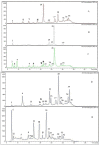Antioxidant capacity and HPLC-DAD-MS profiling of Chilean peumo (Cryptocarya alba) fruits and comparison with German peumo (Crataegus monogyna) from southern Chile
- PMID: 23385342
- PMCID: PMC6270219
- DOI: 10.3390/molecules18022061
Antioxidant capacity and HPLC-DAD-MS profiling of Chilean peumo (Cryptocarya alba) fruits and comparison with German peumo (Crataegus monogyna) from southern Chile
Abstract
Liquid chromatography (LC) coupled with UV detection and electrospray ionization (ESI) tandem mass spectrometry (MS/MS) was used for the generation of chemical fingerprints and the identification of phenolic compounds in peumo fruits and aerial parts from southern Chile. Thirty three compounds (19 of these detected in C. alba and 23 in C. monogyna) were identified, mainly flavonoid glycosides, phenolic acids, anthocyanins and flavonoid aglycons. Total phenolic content and total flavonoid content was measured for both species, and were higher in the extracts from C. monogyna fruits and aerial parts than extracts from C. alba. The fruits of Cryptocarya alba (Chilean peumo) presented high antioxidant capacity (9.12 ± 0.01 mg/mL in the DPPH assay), but was three times lower to that of Crataegus monogyna (German peumo) (3.61 ± 0.01 mg/mL in the DPPH assay).
Figures











Similar articles
-
Antioxidant capacity and inhibition of metabolic syndrome-associated enzymes by Cryptocarya alba fruits.Food Res Int. 2023 Nov;173(Pt 2):113343. doi: 10.1016/j.foodres.2023.113343. Epub 2023 Aug 6. Food Res Int. 2023. PMID: 37803697
-
Antimutagenic evaluation of traditional medicinal plants from South America Peumus boldus and Cryptocarya alba using Drosophila melanogaster.J Toxicol Environ Health A. 2017;80(4):208-217. doi: 10.1080/15287394.2017.1279574. Epub 2017 Mar 17. J Toxicol Environ Health A. 2017. PMID: 28304234
-
Anthocyanins and antioxidant capacities of six Chilean berries by HPLC-HR-ESI-ToF-MS.Food Chem. 2015 Jun 1;176:106-14. doi: 10.1016/j.foodchem.2014.12.039. Epub 2014 Dec 18. Food Chem. 2015. PMID: 25624212
-
Antioxidant capacity, polyphenolic content and tandem HPLC-DAD-ESI/MS profiling of phenolic compounds from the South American berries Luma apiculata and L. chequén.Food Chem. 2013 Aug 15;139(1-4):289-99. doi: 10.1016/j.foodchem.2013.01.089. Epub 2013 Feb 13. Food Chem. 2013. PMID: 23561108
-
Botanical, Phytochemical, Anti-Microbial and Pharmaceutical Characteristics of Hawthorn (Crataegusmonogyna Jacq.), Rosaceae.Molecules. 2021 Nov 30;26(23):7266. doi: 10.3390/molecules26237266. Molecules. 2021. PMID: 34885847 Free PMC article. Review.
Cited by
-
Antioxidant, Antimicrobial Effects and Phenolic Profile of Lycium barbarum L. Flowers.Molecules. 2015 Aug 17;20(8):15060-71. doi: 10.3390/molecules200815060. Molecules. 2015. PMID: 26287157 Free PMC article.
-
Evaluation of Polyphenolic Content, Antioxidant and Diuretic Activities of Six Fumaria Species.Molecules. 2017 Apr 15;22(4):639. doi: 10.3390/molecules22040639. Molecules. 2017. PMID: 28420145 Free PMC article.
-
Mulinum crassifolium Phil; Two New Mulinanes, Gastroprotective Activity and Metabolomic Analysis by UHPLC-Orbitrap Mass Spectrometry.Molecules. 2019 Apr 28;24(9):1673. doi: 10.3390/molecules24091673. Molecules. 2019. PMID: 31035428 Free PMC article.
-
Phytochemical Insights into Ficus sur Extracts and Their Biological Activity.Molecules. 2022 Mar 13;27(6):1863. doi: 10.3390/molecules27061863. Molecules. 2022. PMID: 35335228 Free PMC article.
-
UHPLC-ESI-ORBITRAP-MS analysis of the native Mapuche medicinal plant palo negro (Leptocarpha rivularis DC. - Asteraceae) and evaluation of its antioxidant and cholinesterase inhibitory properties.J Enzyme Inhib Med Chem. 2018 Dec;33(1):936-944. doi: 10.1080/14756366.2018.1466880. J Enzyme Inhib Med Chem. 2018. PMID: 29734888 Free PMC article.
References
-
- Fuentes-Ramírez A., Pauchard A., Cavieres L.A., García R.A. Survival and growth of Acacia dealbata vs. native trees across an invasion front in south-central Chile. Forest Ecol. Manag. 2011;261:1003–1009. doi: 10.1016/j.foreco.2010.12.018. - DOI
-
- Avello Lorca M., López Canales C., GaticaValenzuela C., Bustos Concha E., Chait A.B., Pastene Navarrete C.E., Bittner Berner C.M. Antimicrobial effects of extracts from Chilean plants of Lauraceae and Atherospermataceae families. Rev. Cub. Plant. Med. 2012;17:73–83.
-
- Serce S., Simsek O., Toplu C., Kamiloglu O., Caliskan O., Gunduz K., Ozgen M., Kacar Y.A. Relationships among Crataegus accessions sampled from Hatay, Turkey, as assessed by fruit characteristics and RAPD. Gen. Res. Crop Evol. 2011;58:933–942. doi: 10.1007/s10722-010-9633-x. - DOI
-
- Ding X.P., Wang X.T., Chen L.L., Qi J., Xu T., Yu B.-Y. Quality and antioxidant activity detection of Crataegus leaves using on-line high-performance liquid chromatography with diode array detector coupled to chemiluminescence detection. Food Chem. 2010;120:929–933. doi: 10.1016/j.foodchem.2009.11.014. - DOI
Publication types
MeSH terms
Substances
LinkOut - more resources
Full Text Sources
Other Literature Sources
Medical
Miscellaneous

